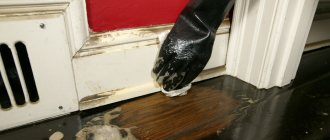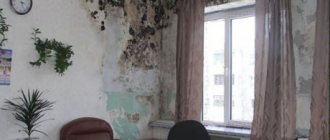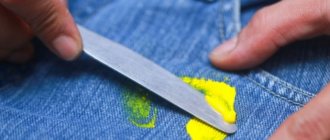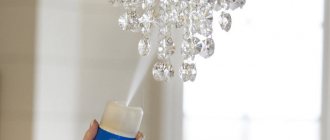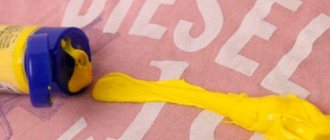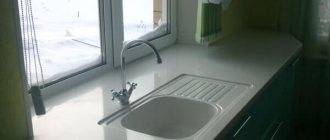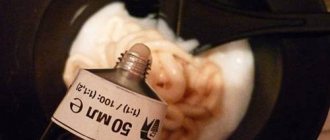Modern trends in room design dictate their own rules in its design. One of the fashionable trends is suspended ceilings. Just before you have time to enjoy the new product, all sorts of troubles happen to it, especially if there are children living in the house. The playfulness of children sometimes horrifies not only the condition of the apartment, but also the condition of the parents themselves. For example, creative chaos from a child's drawing may end up on an expensive stretch ceiling. Adult household members are faced with the problem of how to remove acrylic paint from a stretch ceiling.
If a child makes a blot in front of your eyes, then you shouldn’t think about how to clean the paint from the ceiling. Immediately wipe the surface with a cloth soaked in soapy water. If you do not react in time, the paint will be absorbed into the plastic and it will be impossible to get rid of it. Then the problem of how to remove paint from a stretch ceiling will disappear on its own. Nothing will help you other than a radical method.
How to remove acrylic paint from a ceiling
There are enough ways to remove paint:
Gel intended for washing suspended ceilings. It is, of course, expensive, but you can spend money to save the ceiling covering. If you don't have the opportunity, use more economical options.
Dishwashing liquid or soapy water. Dampen a sponge or rag of any soft material with one of the products and begin washing off the paint. You will have to rub the marks several times. Remember! You cannot scrub acrylic paint in a circular motion, only move forward and move backward.
Hydrogen peroxide. Dampen a flannel rag with a three percent hydrogen peroxide solution and rub the stains. Then wipe dry.
The given methods for removing paint from a ceiling may be useless. In this case, financial expenses cannot be avoided. You will have to seek help from specialists who will remove the damaged part of the ceiling and replace it with a new one. Or use the newest product - a special remover for removing acrylic paint.
Not only acrylic paint, but also water-based and oil paint can get on the ceiling.
More often, water-based paint gets onto the suspended ceiling when, after its installation, painting of the walls begins. There is nothing better than washing water-based paint from the ceiling with plain water at a temperature of 60-70 degrees. Long-standing paint heels need to be passed over several times with rollers dipped in water. The paint should soak for about fifteen minutes. Then we apply mechanical force to the surface. Using a rubber or plastic spatula, scrape off the paint.
Main cycle of work
Next you will have to work on removing the old ceiling covering. Since you will have to work with your arms raised high, you will get tired quickly - do not forget to take breaks. The longer the work lasts, the longer these breaks should be. If you do not follow this advice, then the next day you simply will not be able to raise your arms - it will hurt a lot.
The most common ceiling problem is old whitewash. Natural limestone, classic. The thing is that before the new whitewashing, the old layer was not removed, and the older the apartment, the thicker and more solid the lime layer may turn out to be, and the longer it will take to remove it.
But the process is simple, and in principle, no difficulties should arise when cleaning the ceiling - you just need to thoroughly wet the area and pry off the wet whitewash with a sharp, thin spatula. You can wet everything with a sponge or a spray bottle, it doesn’t matter, and you can do it as you wish.
Methods and methods for removing water emulsion
How to quickly clean the ceiling from different types of water-based paint? To remove water-based paint, there are two universal methods that are used with varying success if you need to remove water-based paint from the ceiling.
- The first way is to soak the paint with warm water using a regular paint roller. In this case, there is no need to soak individual pieces; the entire ceiling can be covered in one go with a roller with a telescopic handle. If the paint is water-repellent, you will have to soak it much longer, several times until it absorbs enough moisture. When the paint swells, it means that it is ready for processing - now all that remains is to remove it with a spatula. In order not to damage the plaster or the surface of the slab with the sharp edges of the spatula, it is best to hold it at the most acute angle relative to the surface of the ceiling. The most stubborn areas can be soaked several more times.
- The second way is to glue newspapers. It will require a stepladder and patience. The paint must be coated with glue, which would be suitable primarily for water-based paint. You need to stick newspapers on it and let it all dry well. After drying, the paint soaked in glue should come off along with the newspapers. Those areas where the glue did not reach, or they simply were not saturated, will need to be re-sealed with newspapers. And tear it off.
Acrylic water-based paint can be easily removed using simple mechanical action. A knife or spatula works great for this. As a last resort, you can use a chisel.
Acrylic paint also washes off well with water; with proper persistence, hot soapy water will quickly remove it from the ceiling without any residue, but you need to rub it well with a washcloth or something similar.
Almost all types of water-based paints can be removed from surfaces using other methods. One of the good and effective methods is the thermal method. The paint is heated using an industrial hair dryer or blowtorch, as a result of which it becomes soft and pliable. Thus, it can be easily removed with a spatula. But for this method it is desirable to ventilate the room well and is certainly not suitable for apartments where there are people.
Another method that can remove almost any paint, regardless of its base, is stripping. It is carried out using a manual grinder, or a special attachment on a grinder or drill. A drill is more convenient.
Using a brush you can remove absolutely all the old paint, without any residue, but this method is very dusty and will require additional protection. It requires, at a minimum, a respirator to protect the respiratory tract from fine and very caustic dust. It is also necessary to cover all objects and furniture in the room with thick polyethylene.
It is also necessary to tightly curtain all doorways and windows. Depending on the area to be stripped and the specifics of the paint, this method can be much more time-saving and much more effective than soaking or using glue, since all the necessary consumables require only a brush with metal bristles.
How to remove water-based paint from a fabric ceiling
Fabric stretch ceilings require more careful maintenance. Fresh water-based paint from such a ceiling can be removed with plain water and a white rag. More persistent traces of paint are washed off with powder, which is first dissolved in water.
If paint stains still remain, then seek help from specialized stores; consultants will tell you how to remove paint from a stretch ceiling. You will be offered a variety of sprays and aerosols for any type of stretch ceiling. Read the instructions and follow their recommendations.
Method one: soaking the paint with water
Old water-based paint can usually be removed easily with hot water. The layer must be soaked and then removed using a spatula or a stiff metal brush. How to remove water-based paint from a ceiling:
- moisten the ceiling generously with warm water using a roller (this should be done several times, as the water will drain);
- wait 5-10 minutes for the substance to dissolve;
- start removing the paint with a spatula or a stiff wire brush;
- wet the ceiling again and continue working step by step.
You need to apply water with a roller to small areas, otherwise they will dry out quickly. You can use a spray bottle to make the process take less time. Removing water-based paint does not take much time. You should definitely take into account: if there were many layers on the ceiling (usually this happens in old apartments), then you will need to repeat the cleaning 2-3 times.
Some craftsmen advise replacing the water with a soap solution and cleaning with it using a sponge. Use it to wash off the dye, generously wetting the ceiling. The technology has many disadvantages, for example, it takes a lot of time and effort to scrub off the substance. If there are several layers of paint on it, it is better to give preference to other methods.
having a waterproof effect
Waterproof paint cannot be removed with water. Therefore, you can use the following options:
Prepare a mixture of PVA glue and starch. Dip the roller into the resulting mixture and apply it to the ceiling surface. Unnecessary paper sheets: from a magazine or newspaper, attach to the treated part of the ceiling. Leave until completely dry. The paint will begin to come off on its own, remaining on the paper.
Use a regular vein in heat mode. When the paint is exposed to hot air, it begins to melt and fall off the ceiling.
We know how to remove water-based paint from a stretch ceiling. But how to remove it from a regular ceiling surface: whitewashed or painted? The stripping method is used here.
For this procedure you must have:
- grinding machine;
- grinder with attachments;
- drill with attachments.
Cleaning the ceiling creates a lot of dirt and dust, so bring a respirator. Cover the furniture in the room with rags or oilcloth. We recommend closing the entrance to the room where the work will be carried out, thereby preventing dust from entering other rooms.
As for how to remove oil paint from a stretch ceiling, this is a very difficult task. Oil paint cannot be exposed to ordinary water; it simply does not dissolve in it. The materials from which the suspended ceiling is made also make it difficult to remove oil paint.
Choice of color and type of coloring material
Water-based paints consist of water, various polymers and color pigments. The ceiling can be painted with several types of paint composition, the properties of which depend on the binder component included in it:
Acrylic paints. The composition includes acrylic resins and latex filler. They form a quickly drying thin film on the surface that is resistant to fading, actively resists water and masks small cracks 1 mm wide.
Silicone paints. A water-dispersed solution based on silicone resin. Covers cracks 2 mm wide, vapor permeable, waterproof, and has antibacterial properties.
Silicate paints. An aqueous solution of potassium glass and colored fillers. The mixture is resistant to temperature changes, biological effects and ultraviolet influence. This is a hydrophobic, vapor-permeable and fire-resistant paint. Disadvantage - not suitable for painting ceilings in rooms with high humidity.
Mineral paints. Made from slaked lime or cementitious substances. Apply to smooth surfaces.
All types of water-dispersion painting emulsions are easily applied to the surface, creating a durable elastic film after drying. They are able to plug microcracks, dry quickly, are odorless and can be tinted in any shade if desired.
Note: read about how to paint the ceiling in the bathroom.
Video on how to remove paint from a stretch ceiling
When creating a modern interior, all designers use stretch ceilings in their design, which are a universal canvas. During installation work, a variety of films are used, which can be glossy, matte, translucent, mirror, different colors and patterns. A stretch ceiling has a huge number of advantages, but in order for it to last as long as possible, you need to take proper care of it. Before you wash the suspended ceiling from all kinds of contaminants, read the basic recommendations for caring for it. This article will reveal all the secrets of caring for a suspended ceiling.
General recommendations
There are several recommendations that will help you cope with the cleaning process faster:
- When trying to get rid of a stain, only wet a small area. Otherwise, the surface dries out quickly, and the procedure has to be repeated again;
- paint sometimes gets on furniture. Don't wait until it dries and gets absorbed. Wet pigment paint is much easier to remove without the use of physical effort;
- It’s easiest to immediately blot water emulsion that has dropped onto clothing with a napkin, but if possible, you can immediately rinse the contaminated area with running water.
Selection of detergents
Before you start cleaning the film, it is fundamentally important to buy high-quality care products for stretch ceilings and appropriate sponges and wipes. It is extremely important to use soft sponges (possibly rags) that will not damage the ceiling film.
The best option for cleaning various surface contaminants are special means, thanks to which it is also possible to get rid of soot.
Note! Do not use products that contain acetone, as it can corrode the PVC.
When using products with an alcohol solution, the washing process will be quite easy. After cleaning, you need to wipe the entire ceiling with a dry microfiber cloth to ensure shine and avoid streaks.
Note! Microfiber is a modern moisture-absorbing material that has gained a lot of use in our time.
Where to start?
Before you begin directly removing paint from the surface, it is necessary to determine the type of coating treated with dye. The method of how to wash off water-based paint will depend on this. You should also prepare in advance all the necessary equipment for this work.
- Lay plastic film or newspapers on the flooring so that all debris from the wall does not contaminate the linoleum or parquet.
- Prepare a basin or bucket with clean water and rags.
- You will need spatulas to scrape off any remaining paint.
- Find a soft-bristle roller to wet the walls or ceiling with water.
- Use a wire brush to scratch the surface of the paint to get water into the paint.
- Prepare sandpaper.
- Solvent or acetone will help achieve better results.
- Put on work clothes.
- Prepare a ladder or stepladder to increase access to surface treatment.
General advice on care and cleaning
Stretch ceilings must always be monitored in order to prevent the formation of a huge amount of contaminants that are difficult to get rid of. It is precisely on this basis that it is worthwhile to clean the surface in a timely manner. If you don’t have the desire to organize wet cleaning with a stepladder every month, then you can also use the dry cleaning option - using a vacuum cleaner.
Note! When using a vacuum cleaner for simple cleaning, do not touch the PVC film with the nozzle, as it may be damaged.
When carrying out wet cleaning with simple detergents (for example, dishwashing detergent, soap, washing powder), you should use warm water within 40°. To clean the glossy surfaces of a stretch ceiling, it is better to use alcohol-based products (this can be a window cleaner). If there is a large amount of different contaminants on the surface of the ceiling, then it is worth buying a set of special products for caring for the suspended ceiling.
Note! When choosing a product for cleaning the ceiling surface, it is fundamentally important to take into account not only the type of contamination, but also the type of fabric (fabric, mat, gloss).
Experts recommend cleaning all types of suspended ceilings (both fabric and film) with a soap solution once a year, this will avoid a huge accumulation of dirt.
How to decide on a method
When choosing the optimal method for removing traces of water-based paint, the following factors must be taken into account:
- Type of base being cleaned. It is easiest to clean waterproof, chemical-resistant surfaces (ceramics, some types of metals). In this case, various chemical removers work well. It is necessary to determine whether the material absorbs paint and how it reacts to chemical or mechanical stress.
- Type of paint. Water-based paints are waterproof and simple. In the case of simple materials, you can use simple washing, with preliminary soaking of dried stains. It is useless to soak waterproof stains: they can only be removed mechanically or chemically.
- Features of pollution. Much depends on the size of the stain you need to get rid of. Another important factor is the condition of the stains. The easiest way is with fresh marks - they can be removed with plain water. Dried paint is much more difficult to remove.
Cleaning the kitchen
The relevance of cleaning the suspended ceiling in the kitchen is very important, since this is where the surfaces are most susceptible to contamination - cleaning must be carried out many times more often. Due to the constant preparation of food, drops of fat, soot, etc. fall on the surface.
To clean a stretch ceiling from grease, just use dishwashing detergent, water and a soft sponge. When finished, wipe the surface dry. If the area of contamination is small, then it is possible to use simple wet wipes.
In specialized stores you will find wet wipes designed for caring for stretch ceilings. In just a couple of minutes. the stain will be removed.
Prompt cleaning
It happens that you have to immediately remove the water emulsion from delicate surfaces, for example, from wallpaper. To prevent the paint from being absorbed and ruining the appearance, mix water and gasoline in the same ratio. Dip the sponge into the mixture, then use the rough side to remove the stain. Work in a circle: from the outside to the inside, making sure that only the stain is removed and not the layer of wallpaper. Next, gently blot the area with a paper kitchen towel. Wait for it to dry and evaluate the result.
On a note! If the stain still remains, then nothing can be done about it. You need to cut out the defect and replace it with a similar piece of wallpaper.
Removal of special types of contaminants
If the suspended ceiling is installed for a long time, then the walls have to be updated after a certain period of time. During the repair work, various painting and priming solutions may get onto the ceiling surface, which dry out very quickly and are quite difficult to remove.
In order to get rid of paint, you need to quickly wipe the stain with a wet rag (as quickly as possible after it ends up on the PVC film). If the stain has already dried, then moisten it well with water, after which the paint will swell and pull away from the film.
Note! A good way to clean water-based paint is plain water. Its remains can be cleaned with a small amount of white spirit.
Using the same method, it is possible to remove traces of glue: a small amount of white spirit or glass cleaner is applied to the stretch ceiling and the stain is carefully removed. The most difficult task is to clean the dirt from the primer. If this is a fresh stain, then you can get by with a small amount of white spirit, but if this is an old stain, then you should choose products specially designed for this purpose.
Nowadays, cleaning organizations are very common, which at an experienced level clean all surfaces, as well as suspended ceilings, from all types of contaminants, including soot stains.
How to remove fresh stains from different types of fabrics
After repairs, work clothes look dirty. Water-based paint leaves streaks and stains. You must be able to remove stains using proven methods.
Denim
It is more difficult to remove bright stripes from thick fabric. You can try wiping the stains with a solvent such as white spirit or acetone. Then the item is placed in the washing machine, rinsing thoroughly at the end.
Natural
Satin and cotton robes and cotton shirts are cleaned with gasoline, placing paper under the material. Solvents also help get rid of contaminants. At the end, be sure to wash things in soapy water.
Synthetics
It’s easy to ruin an item made of polyester or other synthetic material if you use solvents to remove stains. Here it is better to use vegetable oil. Moisten a cotton pad with oil and wipe away dirt. You need to put paper under the fabric. It will take a long time to wipe off the dirt. When the goal has been reached, the item is washed in a soapy solution.
Washing off with water
If the old paint is not waterproof, you can wash it off with plain water.
To work you will need:
- ladder;
- putty knife;
- roller on a long handle;
- brush with metal bristles;
- bucket with water;
- respirator and glasses.
Preparatory work
A good start is the success of the whole business. Simple actions at the very beginning of work will facilitate the entire subsequent process and save effort and time.
- floors, furniture and things must be covered with protective film;
- prepare a stepladder or table;
- fill a bucket with water;
- wear goggles and a respirator.
Soaking old paint
- Using a roller on a long handle, wet the old layer of paint with water and leave it for about 15 minutes, after which you need to walk the wet roller over the ceiling again. The coating should become wet and pliable.
- Using a spatula, scrape off the wet mass, periodically re-wetting the stubborn areas.
- Sand the stripped ceiling down to the very base.
Advice. You can make it easier to soak the old layer by adding a bottle of iodine to a bucket of warm water. And if you then create a draft in the room, the paint will swell and it will be easier to clean the ceiling.
The acrylic-based composition will be easier to remove if you add vodka or salicylic acid to the soapy water.
Soap solution
To enhance the effect of water on the paint, add soap, washing powder and a little iodine to its composition.
Operating procedure:
- Prepare the solution. To do this, you will need a bucket of warm water, laundry soap (1 bar), washing powder (or dishwashing detergent) and a little iodine (a tablespoon).
- Using a brush or roller, apply the prepared solution to the contaminated area. After this, pause for 30-40 minutes so that the mixture is well absorbed.
- Wash the surface using a cloth and clean water. After washing, the remaining water must be removed. There should be no stains or streaks left on the base.
Washing off with special means
If a waterproof compound was used when painting the ceiling, it will be very difficult to wash it off with plain water. In this case, you can use a special active agent - paint remover. The solvent penetrates the old layer, softening it, so it will not be difficult to remove the swollen paint with a spatula.
It comes off well within the first minutes after applying the product. Each type of paint has its own solvent, but it’s easier to choose a universal one.
Types of water-based paint removers
- DOCKER S4 remover is a universal, quick-acting solvent (4–8 min.), ready for use. The remover, thanks to its gel-like viscous structure, is conveniently applied to the ceiling. How to remove water-based paint from a suspended ceiling? Already in the first minutes of exposure, the water-based emulsion begins to bubble, and it can easily be removed with a spatula.
- ELKON S remover is suitable for removing old paint from brick, concrete and metal substrates. Effectively copes with silicate, silicone, acrylic or mineral water-based paint. Its advantages: versatility of use, quick action (10–30 min.), removal of up to 3 layers of paintwork at a time, non-corrosive (does not destroy surfaces).
- The APS-A77 remover will help clean almost all types of surfaces from paint and varnish. Reaction time ranges from 2–10 minutes. (for single-layer surfaces) up to 1.5 hours (in case of thick-layer coatings). The advantageous difference of this wash is that it is relatively safe: the product does not contain aggressive substances phenol and monoethanolamine.
- FAIL-4 remover is a solvent in the form of a thick liquid. Exposure time – 15–60 minutes.
Important! Removers are chemical products containing substances hazardous to health and the environment. How can I wash off water-based paint?
When working with them, you definitely need a respirator, goggles and gloves, and the room must be well ventilated! After working with the product, the remaining remover must be washed off the ceiling with water or a special detergent.
The algorithm for working with washes is similar to washing off paint with water:
- The entire surface of the ceiling is scratched with a metal brush. The water-repellent layer will be damaged, and the product will more easily wet the old coating.
- The ceiling is lubricated with solvent using a brush or roller, and the time indicated on the package is maintained.
- The separated layer of paint is removed with a spatula.
Advice: you should not allow the time of exposure of the remover to the surface to exceed the specified time, otherwise the dried product will turn from an assistant into a problem that is not easy to fix. The remover will also help remove paint stains on the floor and some objects (carefully read the recommendations on the label and strictly follow the instructions).
Washing and related steps
Before starting work, you need to thoroughly wet the surface of the ceiling using a soft roller, regularly dipped into a container of water. Then the coating is left to soak for 15-20 minutes. It is best not to treat the entire ceiling at once, because by the time the work reaches the opposite corner, everything will be dry again.
Using a spatula, carefully, trying not to leave scratches, remove the soaked paint from the ceiling. In order for it to lag better, it is recommended to tap it lightly with a small hammer. Then the spatula will simply remove it in layers. Where difficulties are encountered, you can use a wire brush or wet the coating again.
There are little secrets of rinsing from those who have done this many times:
- add a bottle of iodine to a bucket of water, this will make the process easier;
- rinse off not with plain water, but with a soap solution, this speeds up the work;
- you can apply the soap solution with a brush and then remove it with plain water;
- for paints on different bases there are certain chemical additives (for acrylic, for example, salicylic acid or vodka).
There are also several types of construction removers, which are applied in a layer to the ceiling, left for 15 minutes, and then easily and simply removed from the ceiling with a spatula
But it should be remembered that this method of flushing leads to contact of the respiratory system with harmful chemicals, and you must either work in a respirator or use them with the greatest caution. Washing off water-based paint is the simplest and most affordable way, however, new technologies have led to the creation of water-resistant materials on various bases that cannot be removed with plain water or even a cleaning solution.
Mechanical method
You can remove waterproof paint using a drill with a sanding attachment. The disadvantage of this method is the large amount of dust generated. A protective film on the floor and furniture and a damp cloth at the entrance will help partially correct the situation.
To work you will need:
- ladder;
- respirator and glasses;
- drill with grinding attachment.
A nozzle with metal bristles will help you quickly clean thick layers of paint in places where it could not be washed off.
Equipment and necessary equipment
It is better to carry out the removal process in a completely cleared room, but sometimes this is not possible, and then before the procedure all objects are removed from the furniture, the surfaces are covered with a layer of fabric, and on top - with plastic film. This is a necessary measure to prevent contamination. It is recommended to spread the film in an empty room, so as not to bother with time-consuming cleaning and not think about how to remove untidy marks from the floor.
Anyone who will remove the ceiling layer must be suitably equipped: be sure to wear protective clothing, goggles, gloves and a head covering. If you have a respirator, you can use it to avoid getting paint and dust particles into your lungs.
It is advisable that household members, strangers and idle advisers do not hang out in the room. In addition to emotional disturbances, they will also trample the paint being removed on the floor. In order to reach the ceiling, you will need a construction stepladder or an old stable table if you don’t have one.
To carry out the work directly, you will need very simple tools:
- rags, preferably natural, moisture-absorbing;
- container with water (basin or bucket, for ease of movement);
- soft roller for wetting the surface;
- sandpaper of different grain sizes;
- metal spatula;
- scraper with a comfortable handle;
- brush with metal teeth:
- construction solvent;
- acetone.
Water-based paint can be removed in different ways: rinse with water, remove by heat treatment, using solvents. It all depends on what surface and how many times it was applied and how long it served as a decorative agent in the room. The paint can simply be peeled off with a brush or sander. How to remove it must be decided on the spot, based on the allotted time and available funds.
Thermal method
- ladder;
- construction hair dryer;
- scraper or spatula;
- sandpaper;
- sponge;
- water.
In this case, small areas of the old paint layer are heated with a hair dryer. When exposed to heat, the paint peels off and can be easily removed with a scraper or spatula. The remaining areas are cleaned with a brush and sandpaper, and after that the ceiling is washed well with a damp sponge.
Is it possible to paint over the old layer?
Very often people are too lazy to remove old coverings from walls, floors or ceilings. It is impossible to say exactly how many layers can be applied. Typically, a plastered ceiling is covered with 1-2 layers of paint, which is updated every few years. In appearance it seems that the layer is thin and nothing will happen if you apply a couple more. After some time, the paint begins to crack and bubble - the coating becomes, to put it mildly, imperfect. Removing that much paint will take a lot of time and effort.
It is better to remove old layers during each repair, and this applies to both oil paint and water-based paint. If you have to suffer with the first one, the second one is washed off quickly even with water; cleaning does not take a long time. In cases where there is no desire to do this, it is recommended to at least thoroughly sand the ceiling to remove all detachments.
Water-based paint is an excellent solution for painting walls or ceilings. It is matte, dries quickly, has no unpleasant odor and holds up well. Many people prefer not to remove the old coating before applying new layers, but in vain. This is what influences the final result. With the help of water and newspapers it is easy to get rid of unnecessary coating in a matter of hours.
2/5 — (4 votes)
Using wallpaper glue or paste
Necessary tools and means:
- ladder;
- putty knife;
- old newspapers;
- wallpaper glue or paste;
- sponge.
You need to stick newspapers or any other paper on the ceiling over the paint. Let it dry well and, using a spatula, pry the newspapers off the ceiling along with the paint. Finish the remaining areas after cleaning with a spatula or brush.
This method has a small drawback: the drying process of pasted newspapers can take several days.
Advice. You need to stick the paper to the ceiling very carefully so that it lies in an even layer over the entire surface, without air voids. In this case, it will be easy to tear off the paper along with the paint.
Which method of removing old paint to choose is up to you. How to remove oil paint from wood at home? Having the necessary tools and funds, the budget allocated for repairs, skill and experience will help you make the right decision.
Method two: newspapers and glue
When the first method does not quite help and there is still paint left, it is better to resort to newspapers. We can say that this method takes less effort, but requires more time. You will need to weld a paste or prepare wallpaper glue, a spatula, a stepladder, a wide brush or a sponge. How to remove water-based paint from a ceiling using newspapers:
- lubricate a small area of the ceiling with adhesive;
- glue newspapers on top;
- leave for a while so that the newspapers dry;
- pry the paper with a spatula along with the paint and carefully tear it off;
- Remove the remaining paint with a stiff brush.
We recommend: How to get rid of foot odor - odor remover
The only disadvantage of the method is the need to wait for the glue to dry, and this can take from a couple of hours to several days. It all depends on the temperature in the room: in the summer the process goes much faster than in the cold season.
